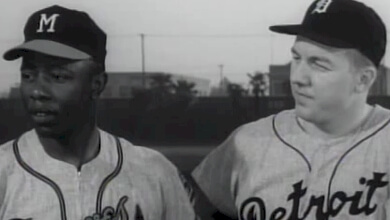One of the most popular attractions of baseball’s annual All-Star Game is the home run derby, where baseball’s long-ball artists target the seats in an orgy of free-swinging oneupmanship. For all the fun of watching the likes of Yoenis Cespedes and Prince Fielder popping fat pitch after fat pitch into the stands, I’m still partial to the original “Home Run Derby,” the short-lived TV series that first aired in 1960.
Sure, that old black-and-white show was a low-key, low-budget affair, especially when compared with the high-decibel corporate-sponsored affair that rocks our senses on ESPN. I guess that’s why I love it so. The show carries me back to a decidedly different era – a time when two eight-team leagues played a 154-game schedule, such monstrosities as artificial turf, domed stadiums, wild-card playoffs, and the designated hitter had yet to be introduced, and the game’s top stars lacked the super-hero physiques, zillion-dollar contracts, and prison-yard ‘tude of today’s players.
According to pop-culture historian Don Zminda, the premise of “Home Run Derby” was simple. “Each week, two major-league sluggers would face off in a home run hitting contest that would last nine ‘innings.’ A home run counted as a run, but any batted ball that failed to reach the seats, as well as any taken pitch that was called a strike by the umpire, was considered an out. With that format, each contest could easily be completed in a half hour.”
The show’s 26 episodes were filmed over a three-week period in December 1959 at Los Angeles’s Wrigley Field (the future home of the expansion Angels). The show’s emcee and producer was Mark Scott, a popular 45-year-old Los Angeles broadcaster who’d also appeared in a handful of Hollywood films. Scott used his contacts to line up an impressive roster of contestants, featuring all but four of the 20 players who had hit 25 or more home runs in 1959. This included Willie Mays, Mickey Mantle, Ernie Banks, and several other future Hall of Famers.
If you’re a Detroit Tigers fan, your favorite episode is undoubtedly Episode 10. It’s a match-up of arguably the two best all-around right fielders in the game: Hank Aaron of the Milwaukee Braves and our own Al Kaline, the only Tiger to compete in the series. It’s remarkable how unremarkable both 25-year-old sluggers look. No chiseled physiques here, no ballooning craniums. No tattoos or diamond studs or bracelets or mountain-man beards, either. Like all big leaguers back then, they’re not even wearing batting gloves.
“Fellas, today you’re gonna go for the big money,” Scott says at the start of the show, where he greets both competitors at home plate. “The winner will receive $2,000. The loser, $1,000.” Scott runs down the bonuses paid for a player hitting three or more consecutive home runs, and it’s a hoot to see Al and Hank look at each other and grin at the thought of winning so much money. Maybe they can afford that station wagon for the wife and kids, after all.
As it turns out, Hammerin’ Hank out-hammers Kaline, 5 to 1. Aaron is invited back while Al, the runner-up, leaves with a check for $1,000, which is disappointing but I suppose still enough to panel the rec room in his basement. Aaron went on to collect a grand total of $13,500 over the next several episodes before losing, making him the show’s big cash winner, though the actual champion was Mickey Mantle, who overpowered Jackie Jensen in the finale.
“Home Run Derby” debuted in April 1960 and ran weekly throughout the summer. It lasted just one season, due to Scott’s untimely death of a heart attack that July. Without the show’s creative force, producers decided to end the series, denying such emerging sluggers as Norm Cash, Harmon Killebrew, Willie Horton, Willie McCovey, and Frank Howard a chance to swing for cash prizes.
ESPN briefly resurrected “Home Run Derby” as a late-night curiosity a few years ago. Happily, today the entire run is available on DVD. Episodes also can be found on YouTube, including the one featuring Kaline and Aaron, which is included below.




jerry vaile
Could you please tell me who was the original sponsor on tv back then for Home Run Derby? I say a cigarette company and my friend says a beer company.